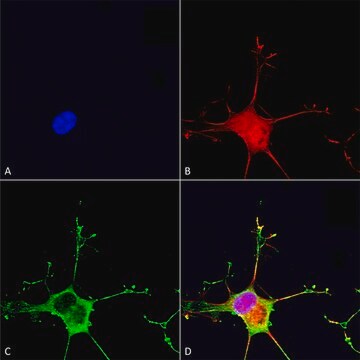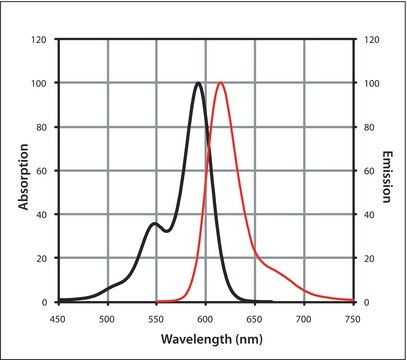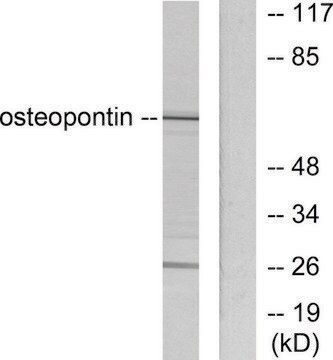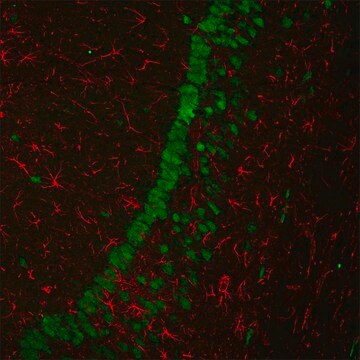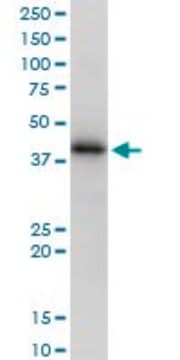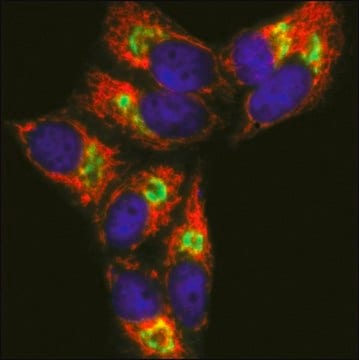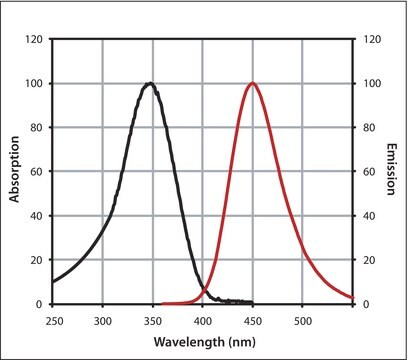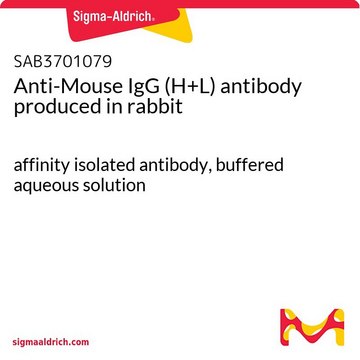General description
Anti-Rabbit IgG (H+L) is a secondary antibody raised in goat against primary rabbit immunoglobulin G (IgG). The monomeric antibody is a ′Y′ shaped structure with two light chains and two heavy chains connected by disulfide bonds in the conserved cysteine residues. Both the light and heavy chains possess variable and constant domain. Light chain has one variable and one constant domain and heavy chain has one variable and three constant domains. IgG is about 150 kDa and is the predominant immunoglobulin in the body. The half-life of IgG is longest compared to other types of immunoglobulins. In bovidae, there are two major subtypes of IgG, namely IgG1 and IgG2. IgG1 is the predominant IgG in serum and colostrum.
This product is prepared by labeling highly cross-adsorbed goat anti-rabbit IgG (H+L) with CF405M. CF405M is spectrally similar to and as bright as Pacific Blue dye but is significantly more photostable than the latter. An additional advantage of CF405M is that it has less spillover in the 525/50 green channel than Pacific Blue dye due to narrower emission peak, making CF405M a superior choice in multi-color detection applications. To minimize cross-reactivity, the antibody has been adsorbed against Human, Mouse, and Rat serum.
Specificity
Binds all rabbit IgGs (minimal cross-reaction with human, mouse, rat serum proteins)
Biochem/physiol Actions
Immunoglobulins (Ig) has a wide range of antigenic determinant regions also known as paratope region that binds specific antigen and elicits immune response. The specificity is contributed by the amino acid sequences in the variable region of both light and heavy chains encoded by V genes. Other regions of the antibody has the constant regions encoded by C genes which accounts for its physiological functions.
Features and Benefits
Evaluate our antibodies with complete peace of mind. If the antibody does not perform in your application, we will issue a full credit or replacement antibody.
Learn more.Physical form
Supplied in phosphate buffered saline with 0.05% sodium azide, 50% glycerol and 0.2% BSA.
Preparation Note
Protect from light. The antibody solution should be gently mixed before use.
Legal Information
This product is distributed by Sigma-Aldrich Co. under the authorization of Biotium, Inc. This product is covered by one or more US patents and corresponding patent claims outside the US patents or pending applications owned or licensed by Biotium, Inc. including without limitation: 12/334,387; 12/607,915; 12/699,778; 12/850,578; 61/454,484. In consideration of the purchase price paid by the buyer, the buyer is hereby granted a limited, non-exclusive, non-transferable license to use only the purchased amount of the product solely for the buyer′s own internal research in a manner consistent with the accompanying product literature. Except as expressly granted herein, the sale of this product does not grant to or convey upon the buyer any license, expressly, by implication or estoppel, under any patent right or other intellectual property right of Biotium, Inc. Buyer shall not resell or transfer this product to any third party, or use the product for any commercial purposes, including without limitation, any diagnostic, therapeutic or prophylactic uses. This product is for research use only. Any other uses, including diagnostic uses, require a separate license from Biotium, Inc. For information on purchasing a license to use this product for purposes other than research, contact Biotium, Inc., 3159 Corporate Place, Hayward, CA 94545, Tel: (510) 265-1027. Fax: (510) 265-1352. Email: btinfo@biotium.com.
CF is a trademark of Biotium, Inc.
Disclaimer
Unless otherwise stated in our catalog or other company documentation accompanying the product(s), our products are intended for research use only and are not to be used for any other purpose, which includes but is not limited to, unauthorized commercial uses, in vitro diagnostic uses, ex vivo or in vivo therapeutic uses or any type of consumption or application to humans or animals.

